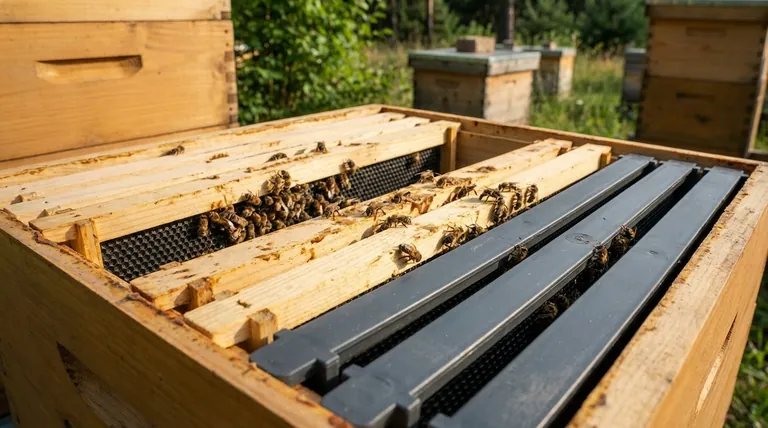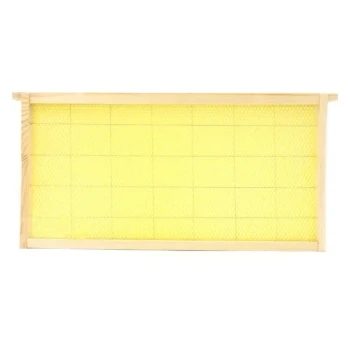The fundamental choice for beehive frame material comes down to two options: wood or plastic. Wood is the traditional, natural choice that bees readily accept, while plastic offers modern durability and low-maintenance convenience. The decision between them impacts your time investment, management practices, and overall beekeeping philosophy.
The question of which frame material to use is not about which is "better," but which is better suited to your specific goals. You are choosing between the natural, customizable nature of wood and the long-lasting, time-saving efficiency of plastic.

The Case for Wooden Frames
Wooden frames are the classic standard in beekeeping, valued for their natural origin and acceptance by honeybees. They are typically made from pine or basswood.
A Connection to Tradition
For many, wood feels more aligned with the natural process of beekeeping. It's what bees would naturally build their comb on in the wild (inside hollow trees), and it has been the go-to material for centuries.
Bee Acceptance and Workability
Bees generally have no hesitation building their comb on wooden frames, especially when paired with a natural beeswax foundation. These frames also allow for customization, as they are assembled from individual parts: a top bar, a bottom bar, and two side bars.
The Challenge of Maintenance
Wood's primary drawback is its susceptibility to the elements. Frames must be assembled, and the wood can warp or rot over time if exposed to moisture. They can also be a target for pests like wax moths, which can burrow into the wood.
The Rise of Plastic Frames
Plastic frames are a modern alternative designed to solve many of the durability issues inherent in wood. They are a popular choice in commercial operations and among hobbyists seeking efficiency.
Durability and Longevity
Plastic is impervious to rot and will not warp. A well-maintained plastic frame can outlast a wooden one by many years, making it a sound long-term investment. They are also highly resistant to damage from pests.
Efficiency and Ease of Use
Most plastic frames come as a single, solid piece, eliminating the need for assembly. They are exceptionally easy to clean and sterilize between uses, which is a significant advantage for disease management.
The Acceptance Factor
The main consideration with plastic is encouraging the bees to use it. Many plastic frames come with a light coating of beeswax, but it's often recommended to add an extra layer yourself to promote quick acceptance and comb-building.
Understanding the Trade-offs
Choosing a material requires a clear understanding of what you are gaining and what you are giving up with each option.
Cost vs. Longevity
Wooden frames often have a lower upfront cost per frame, but they may need to be replaced more frequently due to wear and tear. Plastic frames can be more expensive initially but typically offer a longer service life, potentially reducing costs over time.
Time Investment
Wood requires a significant time investment upfront for assembly and, potentially, painting. Plastic frames save this time but may require the extra step of applying more wax to ensure the bees draw them out properly.
Pest and Disease Management
Plastic's non-porous surface makes it far easier to scrape clean of propolis and wax, and it can be thoroughly sanitized to prevent the spread of disease. Wood is porous and can be more difficult to sterilize completely, potentially harboring pathogens.
Making the Right Choice for Your Apiary
Your decision should be guided by your beekeeping philosophy, the amount of time you can commit, and your operational goals.
- If your primary focus is natural beekeeping and tradition: Wood frames are the clear choice, offering a natural material that aligns with a more organic approach.
- If your primary focus is efficiency, durability, and scalability: Plastic frames provide significant advantages in longevity and ease of management, making them ideal for larger or commercial apiaries.
- If you are a beginner seeking the easiest start: Pre-assembled wooden frames or heavily pre-waxed plastic frames can lower the initial learning curve and get your colony building faster.
Ultimately, the best frame material is the one that supports your hive's health and complements your personal beekeeping style.
Summary Table:
| Feature | Wood Frames | Plastic Frames |
|---|---|---|
| Material | Natural (Pine, Basswood) | Durable Plastic |
| Bee Acceptance | High (Natural Choice) | Requires Extra Waxing |
| Durability | Can Warp/Rot Over Time | Highly Durable, Long-Lasting |
| Maintenance | Requires Assembly, Painting | Easy to Clean & Sterilize |
| Ideal For | Traditional/Natural Beekeeping | Efficient/Commercial Operations |
Ready to equip your apiary with the right frames?
At HONESTBEE, we supply high-quality beehive frames and equipment to commercial apiaries and distributors. Whether you prioritize the natural tradition of wood or the modern efficiency of plastic, we have the wholesale solutions to support your hive's health and your operational success.
Contact our expert team today to discuss your needs and place your wholesale order!
Visual Guide

Related Products
- Assembled Wooden Bee Frames with Plastic Foundation for Durability and Convenience by HONESTBEE
- Plastic Bee Frame Beekeeping Hive Frames for Wholesale
- Assembled Wooden Bee Frames with Beeswax Foundation Ready to Use by HONESTBEE
- HONESTBEE Wired and Assembled Wooden Bee Frames Foundation for a Thriving Hive
- Heavy-Duty Stainless Steel Clip-On Frame Perch
People Also Ask
- Can beekeepers switch between wooden and plastic frames? Optimize Your Hive's Performance
- What materials are commonly used for beehive frames? Wood vs. Plastic for Your Apiary
- Can old bee frames be reused? Weighing the Risks vs. Rewards for Your Hive
- What are the options for frames in a beehive? Choose Between Wood & Plastic for Your Hive
- How should you dry bee frames after cleaning? Prevent Warping and Ensure Hive Health



















